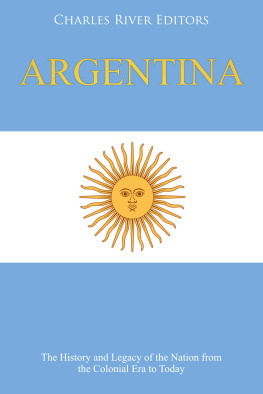Charles River Editors - Vampires and Werewolves: The Legends and Folk Tales about History’s Most Notorious Mythical Beings
Here you can read online Charles River Editors - Vampires and Werewolves: The Legends and Folk Tales about History’s Most Notorious Mythical Beings full text of the book (entire story) in english for free. Download pdf and epub, get meaning, cover and reviews about this ebook. year: 2019, publisher: Charles River Editors, genre: Religion. Description of the work, (preface) as well as reviews are available. Best literature library LitArk.com created for fans of good reading and offers a wide selection of genres:
Romance novel
Science fiction
Adventure
Detective
Science
History
Home and family
Prose
Art
Politics
Computer
Non-fiction
Religion
Business
Children
Humor
Choose a favorite category and find really read worthwhile books. Enjoy immersion in the world of imagination, feel the emotions of the characters or learn something new for yourself, make an fascinating discovery.
- Book:Vampires and Werewolves: The Legends and Folk Tales about History’s Most Notorious Mythical Beings
- Author:
- Publisher:Charles River Editors
- Genre:
- Year:2019
- Rating:5 / 5
- Favourites:Add to favourites
- Your mark:
- 100
- 1
- 2
- 3
- 4
- 5
Vampires and Werewolves: The Legends and Folk Tales about History’s Most Notorious Mythical Beings: summary, description and annotation
We offer to read an annotation, description, summary or preface (depends on what the author of the book "Vampires and Werewolves: The Legends and Folk Tales about History’s Most Notorious Mythical Beings" wrote himself). If you haven't found the necessary information about the book — write in the comments, we will try to find it.
Vampires and Werewolves: The Legends and Folk Tales about History’s Most Notorious Mythical Beings — read online for free the complete book (whole text) full work
Below is the text of the book, divided by pages. System saving the place of the last page read, allows you to conveniently read the book "Vampires and Werewolves: The Legends and Folk Tales about History’s Most Notorious Mythical Beings" online for free, without having to search again every time where you left off. Put a bookmark, and you can go to the page where you finished reading at any time.
Font size:
Interval:
Bookmark:
By Charles River Editors

The Vampire , by Philip Burne-Jones, 1897

Charles River Editors provides superior editing and original writing services across the digital publishing industry, with the expertise to create digital content for publishers across a vast range of subject matter. In addition to providing original digital content for third party publishers, we also republish civilizations greatest literary works, bringing them to new generations of readers via ebooks.
Sign up here to receive updates about free books as we publish them , and visit Our Kindle Author Page to browse todays free promotions and our most recently published Kindle titles.

The Vampire by Edvard Munch
People have always been afraid of the dead. Since the dawn of humanity, people have both cared for those who have deceased yet also tried to keep them away. There are a myriad of legends and beliefs about the dead coming back, and one of the more persistent ones is of the vampire.
Werewolves have long been a staple of popular culture. In the 19 th century and 20 th century, there were countless books, plays, and films about people who turned into wolves or wolf like humanoids and went on rampages. The figure of the werewolf is so familiar that people across the world are familiar with the folklore, and the beliefs that they transform during a full moon, can only be stopped with silver, and transmit their disease by biting their victims.
In fact, those beliefs were not originally part of werewolf folklore, but later embellishments by artists. The belief in lycanthropy is far older and more complex than most people suspect, dating all the way back to antiquity, and werewolves were once assumed to be very real. Indeed, people were even put on trial and executed because the courts of law were convinced they could change their form and kill innocent people. For thousands of years, werewolves have represented a strange and ancient tradition that still echoes through culture to this day.
Likewise, while everyone has heard of vampires, few people are truly familiar with the history and folklore that have made the mythical beings so popular. Indeed, there are so many legends from so many cultures that it is difficult to come up with a hard definition, and folklore is by its very nature unscientific, but most people in the Western world think of vampires as those who come back from the grave to suck the blood or life essence from the living.
This common understanding of vampires actually obscures many European and most non-European traditions of bloodsucking monsters. For example, in China, Japan, and the Middle East, there are spirits that will drain the life force of an unwary person, but these magical beings were never mortal humans. In African and Native American traditions, there are monsters that do the same, but while they are supposed to be of this Earth, they too are not human beings.
Furthermore, folklore changes over time, so the vampires people are familiar with today (and the ones some people claim to actually meet) bear little resemblance to the vampires of early modern Europe. Stories change, fiction turns to fact and vice versa, and beliefs are constantly reinvented. For example, theres this breathless account from the October 20, 1855 edition of the Middlesex Illustrated Times titled A Story about a Vampire:
A German paper relates a curious instance of this popular superstition which recently occurred in Spalato, in Dalmatia:
A young and beautiful girl, the daughter of wealthy peasants, had numerous suitors and from amongst them she selected one of her own station of life. The bethrothal of the young couple was celebrated by a grand feast, given by the girl's father. Towards midnight, the girl and her mother retired to their chamber, leaving their father and the guests at table. All at once the women were heard to shriek dreadfully, and the moment after, the mother, pale and haggard, tottered into the room, carrying her daughter senseless in her arms, and crying, in a voice of indescribable agony, A vampire! a vampire ! my daughter is dead !
The village doctor happened to be amongst the guests and he, seeing that the girl had only fainted, administered to her a cordial, which restored her to consciousness; and he then questioned her. She stated that as she was undressing, a pale spectre, dressed in a shroud, had glided in by the window, rushed on her, and bitten her in the throat - after which, he had disappeared, and she added that she had recognised him as one Krysnewsky, a rejected suitor of hers, who had died a fortnight before.
The doctor attempted to persuade the girl that she must be labouring under some delusion, but she persisted in her story. The parents and all the guests unhesitatingly believed that she had really been bitten by a vampire, and they were very angry with the doctor for presuming to say to the contrary.
The next day, nearly all the men of the village, armed with guns, and all the women, proceeded to the cemetery, uttering dreadful imprecations against the vampire Krysnewsky. The coffin of the deceased was dug up and forced open; and being raised on end, twenty guns were fired at the skull of the corpse. The fragments of the skull were then collected, and in the midst of savage dances and cries, were burned in a huge fire, as was the body itself afterwards.
The girl was taken seriously ill, and continued to get worse for about a fortnight when she died. She constantly persisted in saying that she had been bitten in the throat by a vampire, but she would on no account allow the doctor to examine the wound. After her death, however, he took the bandages from her neck, and found a small wound in the throat, which had the appearance of having been made by a harness makers awl, which had been poisoned. The doctor then learned that one of the rejected suitors of the girl was a harness maker of an adjacent village, and he did not doubt that it was he who had stabbed the girl. He gave information to the authorities, but the young man, hearing that he was about to be arrested, fled to the mountains, and committed suicide by plunging into the torrent.
Vampire researcher Rob Brautigam has discovered that this tale was lifted with few alterations from an 1827 work of fiction by French author Prosper Mrime, but this plagiarism that presents fiction as fact demonstrates the very essence of folklore. Ideas are adopted, adapted, and presented as true. All the while, the legend of the vampire remains.
Vampires and Werewolves: The Legends and Folk Tales about Historys Most Notorious Mythical Beings chronicles how ancient stories about these mysterious supernatural beings became popular and affected history. Along with pictures and a bibliography, you will learn about vampires and werewolves like never before.
The vampires that the world is familiar with today are as much an invention of popular novels and Hollywood as they were an invention of early folk belief. The creations of Bram Stoker and a string of other writers and later filmmakers have little to do with the folkloric origins of the creature. For example, the idea that a vampire must return to his coffin every day is rarely found in the folklore, and while the vampire does tend return to its grave after draining the blood from its victim, it is not required to go there. In fact, Bram Stoker came up with this in order to limit Draculas movements and give his hero a chance to kill him. Similarly, vampires often move around in the daytime, including Stokers Dracula, and the idea of vampires being destroyed by sunlight has its origins in the 1922 silent horror film Nosferatu , directed by F.W. Murnau. The great German director wanted a dramatic end to his monster and thus had him caught out in the sunrise, in the face of which the creature of the night fades away. In later films and fiction, this invention was embellished by having the vampire age rapidly or burn up before turning to ash.
Font size:
Interval:
Bookmark:
Similar books «Vampires and Werewolves: The Legends and Folk Tales about History’s Most Notorious Mythical Beings»
Look at similar books to Vampires and Werewolves: The Legends and Folk Tales about History’s Most Notorious Mythical Beings. We have selected literature similar in name and meaning in the hope of providing readers with more options to find new, interesting, not yet read works.
Discussion, reviews of the book Vampires and Werewolves: The Legends and Folk Tales about History’s Most Notorious Mythical Beings and just readers' own opinions. Leave your comments, write what you think about the work, its meaning or the main characters. Specify what exactly you liked and what you didn't like, and why you think so.


















